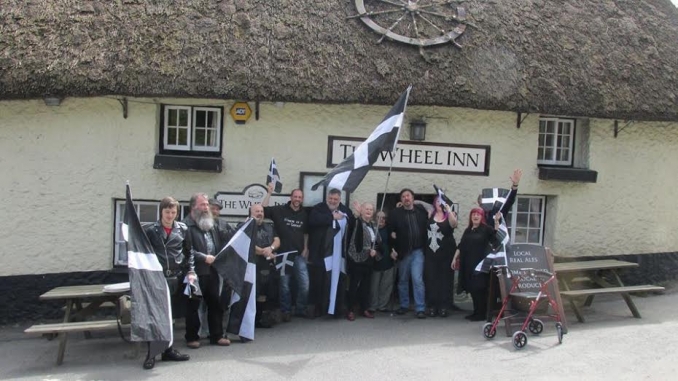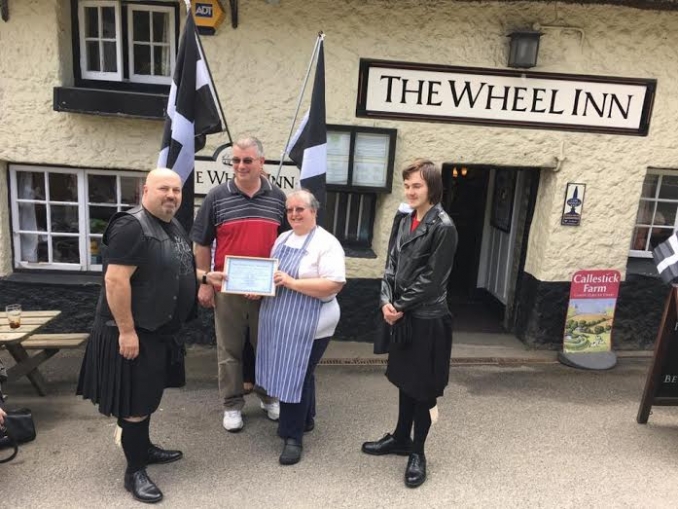Commemoration of the the Peace Treaty of Tresillian Bridge, Cornwall - 12th March 1646
News from Kernow Matters To Us:
Some members of Kernow Matters To Us (KMTU) spent a very pleasant time in Tresillian recently.
With most of our team members being involved with the various events at Camborne's Trevithick Day, a group gathered at the Wheel Inn, Tresillian Bridge just outside of Truro, Cornwall on Saturday 30th April, 2016 in order to commemorate the Peace Treaty of Tresillian Bridge, Cornwall which occurred on 12th March 1646, just over 370 years ago.
KMTU Steering Group Member, Craig Truscott. who is a paramedic reading for his medical degree, is in the process of researching the events in depth and gave a talk to members outlining the historic event.
Members then witnessed a presentation of a commemorative certificate by Craig and his son Ronan to the licensees of the Wheel Inn, Simon and Alison Bellamy flanked by members holding aloft St Piran flags. (photographs attached)
Members then flooded the dining room and enjoyed a meal together followed by a 'shout' - a singing of traditional songs in Cornish and English led superbly by Secretary Matt Blewett and team member, Ekla Edwards.The whole pub came to a standstill and listened in to the songs and holiday makers were handed Piran flags and handouts detailing the peace treaty.
Simon and Alison were delighted and thanked the KMTU team for the presentation and singing which enthralled one and all.
KMTU has seen an enormous growth in members and more such visits of interest are planned in the future.
Craig's presentation is below:
"Take a look around you, at the place where we are currently gathered. Aside from the sound of traffic, birdsong and the river, it is relatively peaceful. Now, if you can, let your mind’s eye take you 370 years into the past, stripping away the sounds and sights of modern life. The bridge is here, though not in its current form. The inn across the river is readying itself for a gathering, as it is today…. And a small nation is about to relinquish its freedom…….
The bronze plaque on the church wall only hints at the momentous events which took place here, following the retreat of the Cornish army from Castle an Dinas where Sir Ralph Hopton, who had taken command after the death of Sir Bevil Grenville at the battle of Lansdown on 5th July 1643. Following an intelligence coup in Padstow harbour, where dispatches for Prince Charles were captured on a ship moored there. The dispatches contained details of a sizeable Irish army due to sail in support of the Royalist cause. Gauging his audience well, and knowing precisely how this news would be received, Cromwell’s deputy Sir Thomas Fairfax had the letter read out in the town square. The response was precisely as he expected……. The reaction of the populace to the King asking mercenaries to bail him out (less than a hundred years after mercenary atrocities during the 1549 war) resulted in Cornish support for the Royalist cause evaporating.
It is well documented that the Royalists never entirely trusted the Cornish army during the war, being a fiercely independent bunch. Parliament both feared and respected them in equal measure, having suffered a great number of significant defeats, and on one occasion complete annihilation on their retreat to Plymouth (and safety) at the hands of both our army and the locals, who quite literally took the clothes from their backs.
Cromwell, who at the time was camped outside Exeter (still in Royalist hands) preventing a link up of the Cornish army with the Royalist forces, tasked Fairfax with obtaining a surrender, peace treaty, ceasefire, call it what you will. We would essentially be signing our independence away.
The significance of this is telling. Why not just march in, rout what is left of an army in disarray and rule a tiny nation by force, as had been done before? After all, Sir Richard Grenville, the deputy commander of the army, and seen by some as a ‘loose cannon’ had been removed from his post and placed under arrest on the Mount (he escaped soon afterwards) for attempting to negotiate privately with Cromwell for a semi-autonomous Cornish republic, with himself at its head. One can only surmise that the mint in Truro would have produced coinage with Grenville on it….!!
Or, as might have been more prudent on Cromwell’s part, treat the Cornish with respect, give Fairfax (who was respected here) a free hand to negotiate, not take the path of retribution and therefore not have an unhappy population with huge potential to be a tinderbox of revolt. Nevertheless, on Saturday 8th March 1646 Hopton partially acceded to Fairfax’s demands. This was not accepted, and further pressure was applied, the Parliamentary army heading west from Bodmin, and further letters being sent, still keeping the level of respect afforded to a national army, and not just a rebellious band of die-hards. Realising that Prince Charles was in the Scillies and preparing to sail for France and exile, Hopton agreed at midnight on Sunday 9th to lay down arms. He named the site where we are now stood as the meeting place, this being the lowest possible bridge over the river, Lieutenant Bonython having surrendered St Mawes Castle, giving control of the eastern side of the Fal to Fairfax and the Parliamentarians.
On Thursday 12th March 1646 Fairfax set up his headquarters in Tresillian, evidence points to the Wheel Inn, but the manor houses at Polsue and Tregurno may also have a claim to this, both being held by families loyal to Parliament at that time. Hopton had agreed to vacate Truro as a goodwill gesture, the army having been stationed at a site today called ‘Campfield Hill’ not far from the cathedral. Hopton moved the main bulk of the army, still numbering in their thousands, out to a site near Allet, thought to be the manor of Caulsigey.
The treaty having been signed, disarmament and disbanding of the army began. St Michael’s Mount, held by Sir Arthur Basset and Pendennis, held by Sir John Arundell held out, Arundell notably giving Fairfax a customary Cornish reply when called upon to surrender!
But that is for another gathering……. As Arundell held out at Pendennis until 17th August.
An interesting footnote is a question around why, during the battles around Lostwithiel and Fowey in 1644, did the Earl of Essex take great pains to destroy the Duchy records at both the Duchy palace, and at the church in Luxulyan…. When everyone else in a Roundhead uniform was more concerned with self-preservation, in full flight from a determined Cornish army, and a local population out for their blood after the plundering of the local area. Was he, as has been suggested, under orders to seek out and destroy documents and treaties relating to us as an autonomous state?"
Footnote:
KMTU has joined the many others demanding return of our £150,000 Cornish language funding! Here is the growing petition created by Dr Jon Mills which we invite you to sign and share:
https://petition.parliament.uk/petitions/128474
Oll an gwella / All the best
John, Teresa, Craig, Tony, Matt, Mike, Clive, Samuel & Ronan
Elected Members of the KMTU Steering Group
![]()


- Mair Williams's blog
- Log in to post comments





